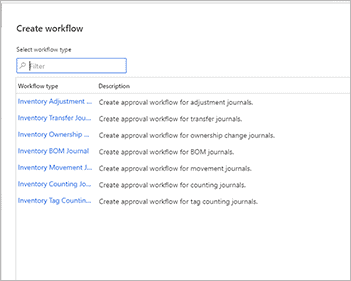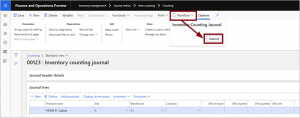Supply Chain and Logistics Management
How to use D365 Inventory Journals to improve Supply Chain
In order to optimize their processes and move towards their goals, businesses always need to improve their Supply Chain Management. In this way, one of the most efficient ways to do this is by the effective implementation of tools like D365 Inventory Journals.
Microsoft Dynamics 365 Supply Chain Management help businesses accomplish their goals by reaching new levels of optimization while satisfying their clients. Defined by quick shifts, the current market drives every company to reevaluate its strategy and take action to help its customers with quality service at the lowest cost possible. Moreover, to increase profitability and reduce risks and losses, companies must embrace new ways to solve their problematic areas. In this way, their Supply Chain Management strategy can no longer be managed with traditional manual methods and obsolete ERP systems. Put it simply, managers need to make proper decisions at different levels: strategic, tactical, and operational
What to consider when using Microsoft Dynamics 365 Inventory Journals to improve your Supply Chain
In this post, we will discuss:
- How does Inventory Management affect Supply Chain?
- How do you manage inventory in Supply Chain Management?
- What is an Inventory Journal?
- What are the types of D365 Inventory Journals?
- How can I improve my Supply Chain Management by using Inventory Journals?
- Finally: D365 Inventory Journals in Supply Chain Management
D365 Inventory Journals: How does Inventory Management Affect Supply Chain?
Firstly, in a nutshell, Inventory Management is the daily activity of counting, following, and registering all the different Inventory Transactions that take place in a business. Now, obviously, there’s more to it than that. In this way, Supply Chain Management is the process that every company follows in order to manage distribution, production, manufacturing, storage, etc. Moreover, in this ecosystem, we can find Inventory Management. The Inventory Management processes are complex and require a lot of strategic thinking and logistics. More importantly, to remain competitive, Supply Chains must be optimized. Therefore, they must develop the capacity to predict any problem and adapt. Is important to mention that reviewing the strategy is fundamental.
In order to make insightful decisions, businesses must optimize the flow of materials from suppliers or manufacturers to end-users. This affects every area of operations: from sales to accounting, and management to customer service. In addition, we cannot forget that planning and monitoring inventories are fundamental for optimized supply chain management. Therefore, easily you can argue that is one of the most important aspects of any type of business. Managing inventory includes a series of tasks that need to function in perfect harmony, every day, every time, always, to meet the organization’s goals.
D365 Inventory Journals: How to Manage Inventory in Supply Chain Management?
Conditions to manage inventory successfully:
- Firstly, Identifying customer service level requirements
- Secondly, Defining the location of inventory along the supply chain, and allocation of stock at each point
- Thirdly, Developing suitable policies for managing the supply chain as a single entity
Moreover, risks must be taken into account in order to make the appropriate operational decisions. In this way, to remain competitive, Supply Chains must have the capacity to overcome problems and obstacles. With this in mind, these are the ways to achieve that.
Techniques to solve Inventory problems:
- Firstly, the analytic approach
- Secondly, the simulation approach
D365 Inventory Journals: Working with Dynamics 365 Supply Chain Management
All the inventory and warehousing process of picking, packing, and shipping goods or parts, needs to be tracked with an automated system like Microsoft Dynamics 365 SCM. For example, if a shipment arrives in the warehouse, the company can just barcode it right into the places where the rest of the storage is, or on the shelves. When it ships out the door, the inventory is dynamically updated with real-time data, which ultimately will give you better information.
The goal is to maximize operational efficiency without compromise product quality at the same time. This way, the entire operation can shift from reactive to proactive. Dynamics 365 SCM with the inventory and warehouse management and all its tools and capabilities, empower the user who knows can oversee the management of stock items across their business. Also, you will be able to keep data about every item and update stock levels, based on outbound sales and inbound purchases.
Remember, with Microsoft Dynamics 365 SCM you will:
- Manage data on every inventory item, including units of measurement, unit costs, sales prices and dimensions
- Group items into hierarchical structures and assign category attributes.
- Assign stock locations and track items from one location to another
- Link items to create a bill of materials for production
- Post-sales and purchases against each item to automatically adjust stock counts
- Link replacement articles to offer alternatives to sold-out products.
- Manage non-stocked items
The importance of automized systems is often underestimated. Mainly because, inventory planners only need to calculate what, when and how much to buy. However, we know that is not as simple as it looks.
D365 Inventory Journals: What is an Inventory Journal?
In Microsoft Dynamics 365 Supply Chain Management, inventory journals are used to make physical inventory transactions. For Example, posting issues and receipts, creating bills of materials or BOMs, inventory movements, etc. All these kinds of inventory journals are applied in a similar way, but they are separated into different types. It’s important to mention that a journal can be open by only one user at a time. If several users need to enter the journals at the same time to create journal lines, those users must select journals that aren’t currently being used, to prevent information from being overwritten.
In circumstances where many departments use the same journal type, it’s necessary to create multiple journal names, for instance, one per department. Also, it can be better to split journals so that each posting routine is accessed in its own unique inventory journal. For these posting routines just mentioned before, which are linked with inventory transactions, you can make one journal for periodic inventory adjustments and another for inventory counting.
What are the Types of D365 Inventory Journals?
We are going to do an overview of these four most used types of inventory journals:

-
Movement Journal
You can use a movement journal to see a preview, you will need to sign in to access a free Azure virtual machine. However, if you’re signed in one Microsoft learn lab environment you will not need to sign again.
-
Inventory Adjustment Journal
You can use an inventory adjustment journal to see a preview, you will need to sign in to access a free Azure virtual machine. However, if you’re signed in one Microsoft learn lab environment you will not need to sign again.
-
Transfer Journal
We have a blog series about these topics, including an article about the inventory transfer journal process. In this way, you can go and check it out to learn more about it. Additionally, you can use a transfer journal to see a preview. For this, you will need to sign in to access a free Azure virtual machine.
-
Counting Journal
You can use a counting journal to see a preview. In order to do this sign in to access a free Azure virtual machine. Moving on, let’s see how you can use Inventory Journals to improve your Supply Chain Management.
How can I improve Supply Chain Management by using D365 Inventory Journals?
In a fast-changing business world, companies must remain competitive. For instance, they need to match their strategies, resources, capabilities, and operations. Moreover, companies will definitely have an advantage over their competitors if they switch from traditional supply chain management to an automatized system like Dynamics 365.
Step-by-Step: D365 Inventory Journals Approval workflows
Set the Inventory Journal approval workflows feature
To use this feature, first, you have to turn it on in your system. Admins can use the feature management settings to verify this. In the Feature management workspace, the feature is listed in the following way:
- Module: Inventory and warehouse management
- Feature name: Inventory journal approve workflow
Then, you need to create the Inventory Approval workflows for each Inventory Journal type.
To create an Inventory Journal approval workflow you need to:
Step 1: Create your inventory journal approval workflows1. Firstly, select Inventory Management > Setup > Inventory management workflows |
 |
 |
Step 2: Assign approval workflows to inventory journal names
|
Step 3: Create an inventory journal and send it for approval
|
 |
Important note: This process aplies to the other types of journals.
Finally, D365 Inventory Journals in Supply Chain Management
But first, here is a summary of all the covered topics. With this in mind, the right inventory strategy depends on both the operations and vision of a company. In this way, Dynamics 365 has excellent tools, like Inventory Journals for example. Moreover, Inventory optimization will produce a stunning impact on supply chain performance for any business, resulting ultimately in better inventory, a cleaner balance sheet, and improved cash flow.
Thank you for reading part 10 of the Supply Chain Series. If you have any questions, you can leave us a comment in the section below. We will get back to you as soon as possible. Additionally, make sure to stay tuned for our next blog post where we will talk more about this and other related topics. Also, you can check the MB-300 and MB-500 courses to learn more about how to train your team in these topics. We are sure you’ll find it useful.
Furthermore, if you want to learn how to optimize your business data using Supply Chain Management, you can reach out to us here. This has been Brandon Ahmad, founder of Instructor Brandon and Dynatuners.

 3808
3808 
